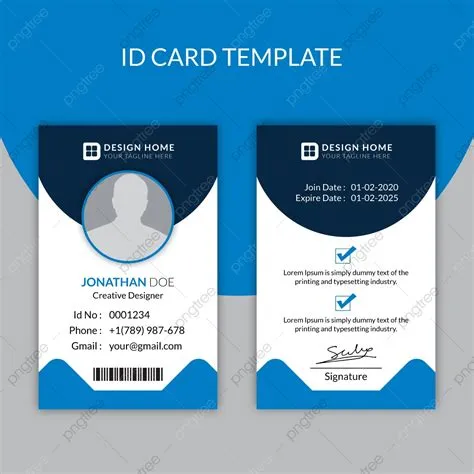Hey there, business owners and branding enthusiasts! Ever thought about your employee ID cards as more than just a piece of plastic? They’re actually powerful little branding tools, mini-advertisements for your company culture, and crucial security identifiers. And just like everything else, ID card design is constantly evolving. Let’s dive into the hottest trends shaping the future of business ID cards.
Beyond the Basic: Embracing Modern Aesthetics
Remember those dull, generic ID cards of yesteryear? They’re practically extinct! Today’s ID cards are all about sophisticated design. Think clean lines, minimalist layouts, and impactful color palettes that reflect your brand identity. Are you a tech startup? Embrace bold geometric shapes and vibrant hues. A more established firm? A refined, classic look might be more suitable. The key is consistency – ensuring your ID card design aligns seamlessly with your overall branding strategy.
We’re seeing a massive shift towards personalization, too. It’s no longer enough to just slap a name and photo on a card. Consider incorporating employee details beyond the basics. Think about adding employee titles, department logos, or even a short, personalized message. This small touch adds a human element and fosters a stronger sense of community within your organization. You can even explore customization and personalization options to create truly unique cards for each employee.
Smart Cards: Integrating Technology for Efficiency
Technology is revolutionizing ID card design, and we’re not just talking about a better printer. Smart cards are becoming increasingly popular, embedding microchips that store data beyond the employee’s name and picture. This allows for seamless access control, time tracking, and even payment functionality. Imagine the possibilities! No more fumbling with keys, simplified payroll processing, and a streamlined employee experience. Think of it as having a mini-computer tucked inside a stylish card.
This technological advancement doesn’t just boost efficiency; it enhances security too. Smart cards provide a robust layer of protection against unauthorized access, safeguarding your company’s sensitive information. Interested in learning more about the integration of technology? Check out our guide on technology-integrated ID cards.
Eco-Conscious Choices: Sustainable ID Card Materials
Sustainability is no longer a niche concern; it’s a core value for many businesses. And that extends to ID card design. More and more companies are opting for eco-friendly materials, like recycled PVC or plant-based alternatives. Choosing sustainable materials is not only good for the planet but also reflects positively on your company’s image. It shows you care about the environment and are committed to responsible business practices.
But the eco-friendly approach doesn’t stop at the materials. Consider eco-friendly printing techniques, such as soy-based inks or water-based coatings. These choices minimize your environmental footprint without compromising on the quality and design of your ID cards. Explore our blog on materials and sustainability in ID card design for more insights.
Industry-Specific Designs: Tailoring to Your Business
One size does not fit all, especially when it comes to ID cards. The ideal design varies greatly depending on your industry. A hospital’s ID card needs will differ significantly from a construction company’s, for example. A hospital might prioritize quick identification of medical personnel, including their qualifications, while a construction company might focus on safety protocols and job site access. This is where industry-specific ID card designs become essential.
Consider the functional aspects of your ID cards. Do you need barcodes for inventory management? Magnetic strips for access control? RFID chips for tracking assets? The best design incorporates these functional elements seamlessly within an aesthetically pleasing and brand-consistent framework. Learn more about the functional aspects by checking our functional aspects of industry-specific ID cards.
Beyond the Physical: The Rise of Digital ID Cards
While physical ID cards remain relevant, the digital realm is rapidly catching up. Digital ID cards offer unparalleled convenience and flexibility. They can be easily stored on smartphones or other devices, eliminating the need for bulky wallets and reducing the risk of loss or damage. Furthermore, digital ID cards can be easily updated, ensuring information remains current. This is an area of increasing importance and we suggest you explore digital and virtual ID cards for your business.
The integration of digital IDs also presents opportunities for enhanced security features. Digital signatures and biometric authentication methods can provide an extra layer of protection against fraud and unauthorized access, making them ideal for organizations handling sensitive information. This shift towards digital ID cards reflects a larger trend towards digital transformation across various industries.
Creative Design: Showcasing Your Brand Identity
Your ID card is a miniature billboard for your company culture. It reflects your values, your brand personality, and your commitment to excellence. So, don’t underestimate the power of creative design! Think outside the box. Incorporate unique imagery, memorable fonts, and innovative layouts that truly capture the essence of your brand. Consider using your ID cards as a subtle yet effective branding tool. A well-designed ID card can strengthen your corporate image, contributing to a positive employee experience and a better perception from clients and stakeholders.
Don’t just see your ID cards as a necessity; see them as an opportunity to showcase your unique brand identity and values. A consistent, professional look across all employee ID cards adds a layer of professionalism and reinforces your company image, both internally and externally. For inspirational design ideas, take a look at our gallery of modern ID card design ideas and learn how to brand with ID cards.
The Future of ID Card Design: A Glimpse Ahead
The world of ID card design is dynamic and ever-evolving. We can expect even more innovation in the coming years. Imagine ID cards with embedded sensors for health monitoring, or augmented reality features that display additional information upon scanning. The possibilities are endless. As technology advances, ID cards will continue to evolve, becoming even more sophisticated and integrated into our daily lives.
Staying ahead of the curve means continuously exploring new materials, technologies, and design trends. By embracing innovation, businesses can enhance their security, streamline their operations, and project a strong, consistent brand image. Begin your journey to updated ID cards by visiting our blog for more industry insights.
Conclusion
Designing effective ID cards is about more than just aesthetics; it’s about strategically aligning your design with your brand, enhancing security, and improving operational efficiency. By embracing modern aesthetics, incorporating smart technologies, making sustainable choices, creating industry-specific designs, and leveraging digital advancements, you can transform your ID cards from simple identification tools into powerful brand ambassadors and efficient operational assets.
FAQs
- What are the most important factors to consider when designing an industry-specific ID card? The most important factors are the specific needs of your industry (access control, security protocols, etc.), the practicality and durability required for the work environment, and how the design aligns with your brand identity. For example, a construction site ID card will need to be more durable than one used in an office environment.
- How can I make my ID cards more environmentally friendly? Choose recycled or plant-based materials, utilize eco-friendly printing methods like soy-based inks, and explore options for reducing the overall size and amount of materials used per card. Consider the whole lifecycle of the card, from production to disposal.
- What are the benefits of incorporating smart card technology into my ID cards? Smart cards offer enhanced security, streamlined access control, the ability to integrate additional employee information, and the possibility of integrating payment or other functional capabilities. They are becoming an increasingly vital element in modern business.
- How can I ensure my ID card design aligns with my brand identity? Maintain consistency in your color palette, fonts, and overall aesthetic. Ensure the design reflects your company’s values and culture. Use design elements that are consistent with your existing branding materials such as logos, colors, and fonts.
- What is the future of ID card design? We can expect increased integration of digital technology, more sustainable materials, enhanced security features, and designs that are more personalized and reflect individual employee needs. Expect advancements in biometrics and potentially even more integration with wearable technology.

